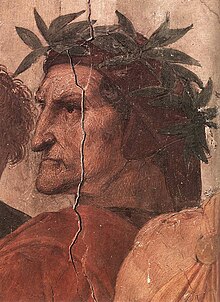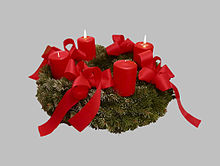wreath

A wreath , derived from the Old High German word "krenzen" ("to wind around"), is, in contrast to the arrangement, a ring-shaped combination of materials, in the narrower sense mostly a combination of leaves , flowers and branches .
Significance and historical use
Since the 5th century BC at the latest The " wreath " is considered to be the symbol of victory .
In ancient Greece , wreaths or branches of certain plants and trees formed the prize in sporting and artistic competitions , for example the laurel wreath at the Pythian Games in Delphi or the oak branch at the Olympic Games in Olympia .
In the Roman Empire , wreaths were also awarded as awards, for example made of oak leaves as " corona civica " for the rescue of a Roman citizen from danger to life or in the form of battlements as " corona muralis " for the first ascent of enemy city walls during a siege .
Wreaths were also modeled in metal; from them the crown developed .
"Wreaths" in the narrower sense
- Advent wreath
- Flower wreath
- Bridal wreath
- Green wreath ("maiden wreath") made of myrtle
- Laurel wreath
- Myrtle wreath (former wedding custom)
- Orange blossom wreath
- Pearl wreath
- rosary
- Wreath
- Straw wreath
- Funeral wreath
"Wreaths" in the broader sense
- Ladies' party
- Bottle ring (" Kuemmerlingkranz ")
- Frankfurt wreath
- "Kranzschwinger", a wrestler who won a prize at several wrestling festivals in the variant of wrestling, which is particularly popular in Switzerland
- Squiggles
- Box wreath
- Schöttelkranz
- Sock wreath
- Wheel flange



